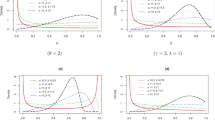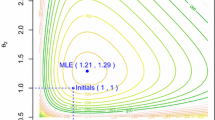Abstract
Most fracture data sets are length-censored because of incomplete exposure at the surface, so estimating values of parameters of the sampled populations is difficult. Unless the form of the distribution function of the population is known, or one which is analytically tractable is assumed, length-censoring presents formidable problems in determining population parameters. Tests conducted on experimental fracture patterns developed in clay samples subjected to simple shear loading are the basis of a distribution-free way to estimate population parameters. Comparison of random samples of censored and uncensored fracture lengths shows that a useful, homogeneous data set consists of those cracks which lie entirely within the sampling area (two-ended cracks). The properties of this data set can be used to estimate the mean and variance of uncensored data. Estimates of the maximum fracture length of uncensored data, using the variance and maximum length of these two-ended cracks, show good agreement with measured values. Knowledge of the mean, variance, and maximum value of fracture-length populations are of interest in engineering and hydraulic studies, as well as in remote sensing studies of the Earth and other planets. Application of these results to data on rock masses are subject to the caveat that different crack-growth mechanisms in clay and rock may affect the accuracy of the calculations.
Similar content being viewed by others
References
Baecher, G. B., 1980, Progressively Censored Sampling of Rock Joint Traces: Math. Geol., v. 12, p. 33–40.
Baecher, G. B., 1983, Statistical Analysis of Rock Mass Fracturing: Math. Geol., v. 15, p. 329–348.
Baecher, G. B. and Lanney, N. A., 1978, Trace Length Biases in Joint Surveys, p. 56–65,in Proceedings of the 19th Symposium on Rock Mechanics, Golden, Colorado.
Baecher, G. B.; Lanney, N. A.; and Einstein, H. H., 1977, Statistical Description of Rock Properties and Sampling,in Proceedings of the 18th Symposium on Rock Mechanics, Keystone, Colorado, 5C1 (1–8).
Bombolakis, E. G., 1976, Some Constraints and Aids for Interpretation of Fracture and Fault Development, p. 289–305,in Proceedings of the Second International Conference on Basement Tectonics, M. Podwysocki and J. Earle (Eds.): Newark, Delaware, 13–17 July, 1976.
Cleveland, W. S., 1985, The Elements of Graphing Data: Wadsworth Inc., Monterey, California, 323p.
Cloos, E., 1955, Experimental Analysis of Fracture Patterns: Bull. Geol. Soc. Amer., v. 66, p. 241–256.
Cruden, D. M., 1977, Describing the Size of Discontinuities: Int. J. Rock Mech. Min. Sci. Geomech. Abstr., v. 14, p. 133–137.
Harris, John F.; Taylor, Garvin L.; and Walper, Jack L., 1960, Relation of Deformational Fractures in Sedimentary Rocks to Regional and Local Structure: Bull. Amer. Assoc. Pet. Geol., v. 44, no. 12, p. 1853–1873.
Lass, H. and Gottlieb, P., 1971, Probability and Statistics: Addison Wesley, Reading, Massachusetts, 470p.
Pahl, P. J., 1981, Estimating the Mean Length of Discontinuity Traces: Int. J. Rock Mech. Min Sci. Geomech. Abstr., v. 18, p. 221–228.
Skempton, A. W., 1966, Some Observations on Tectonic Shear Zones: Proceedings of the First Congress International Soc. Rock Mech., Lisbon, 25 Sept.–1 Oct., 1966, vol. 1, p. 329–335.
Spencer, Edgar Winston, 1959, Geologic Evolution of the Beartooth Mountains, Montana and Wyoming: Bull. Geol. Soc. Amer., v. 70, p. 467–508.
Stearns, D. W., 1968, Certain Aspects of Fractures in Naturally Deformed Rocks, p. 97–118,in N.S.F. Advanced Science Seminar in Rock Mechanics, Boston College, Chestnut Hill, Massachusetts, 26 June–28 July, 1967.
Author information
Authors and Affiliations
Rights and permissions
About this article
Cite this article
de Caprariis, P. An empirical approach to estimating population parameters from censored fracture-length distributions. Math Geol 20, 803–814 (1988). https://doi.org/10.1007/BF00890192
Received:
Accepted:
Issue Date:
DOI: https://doi.org/10.1007/BF00890192




